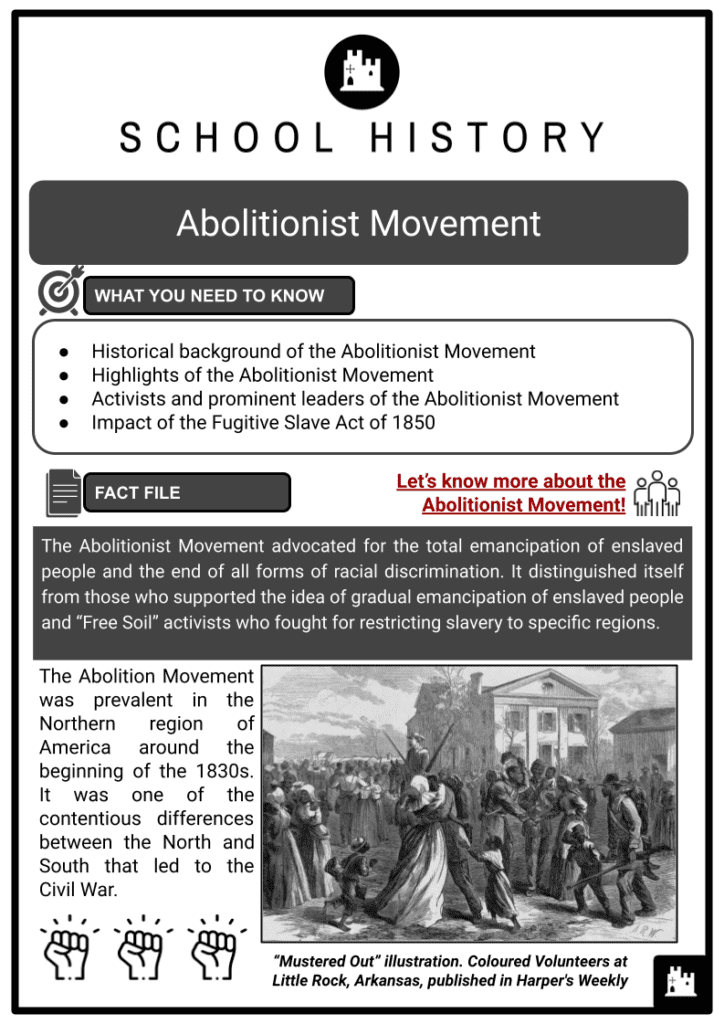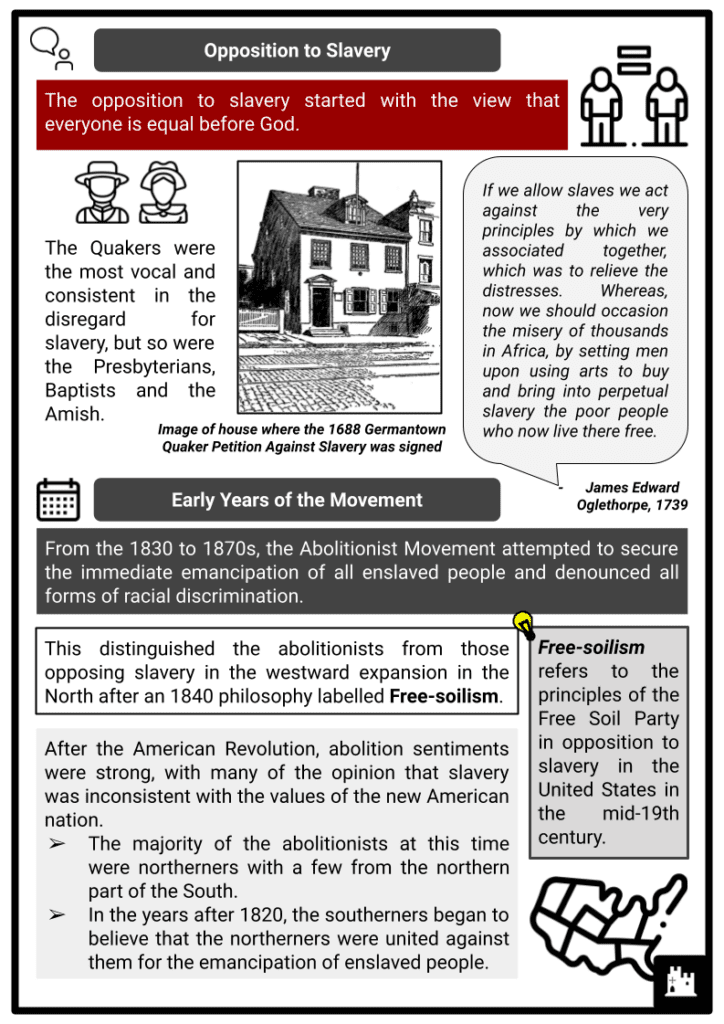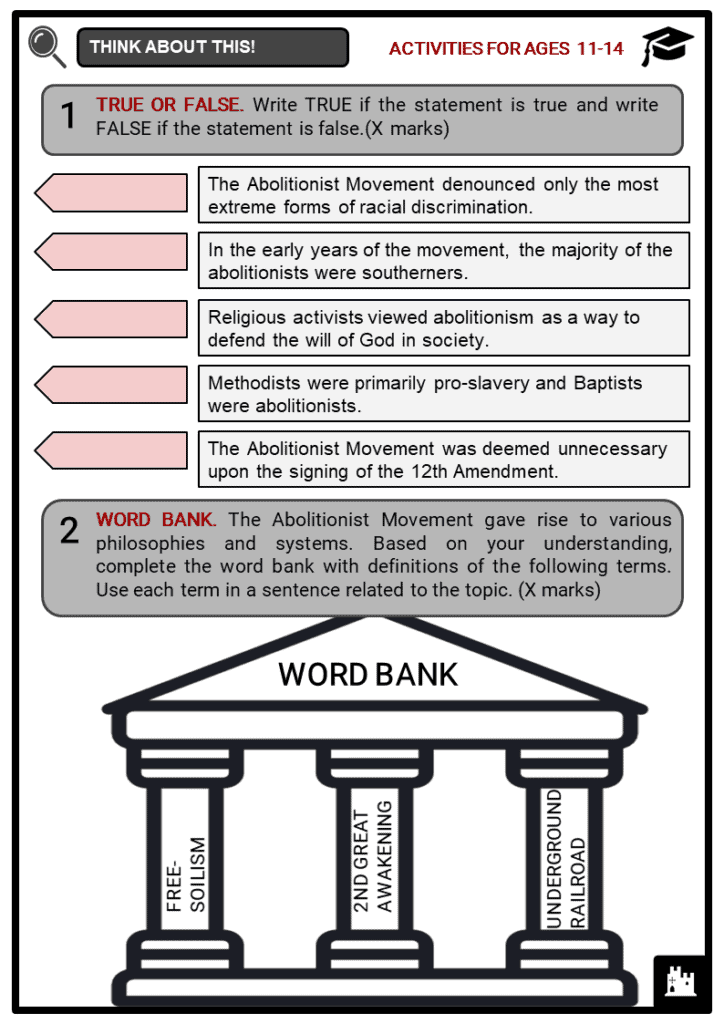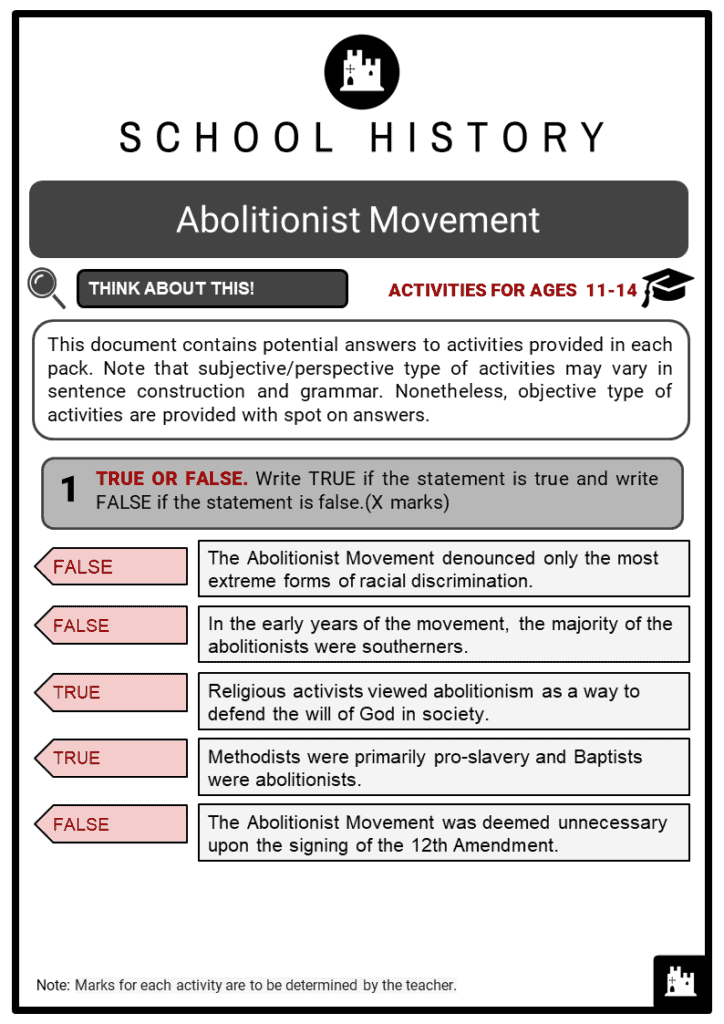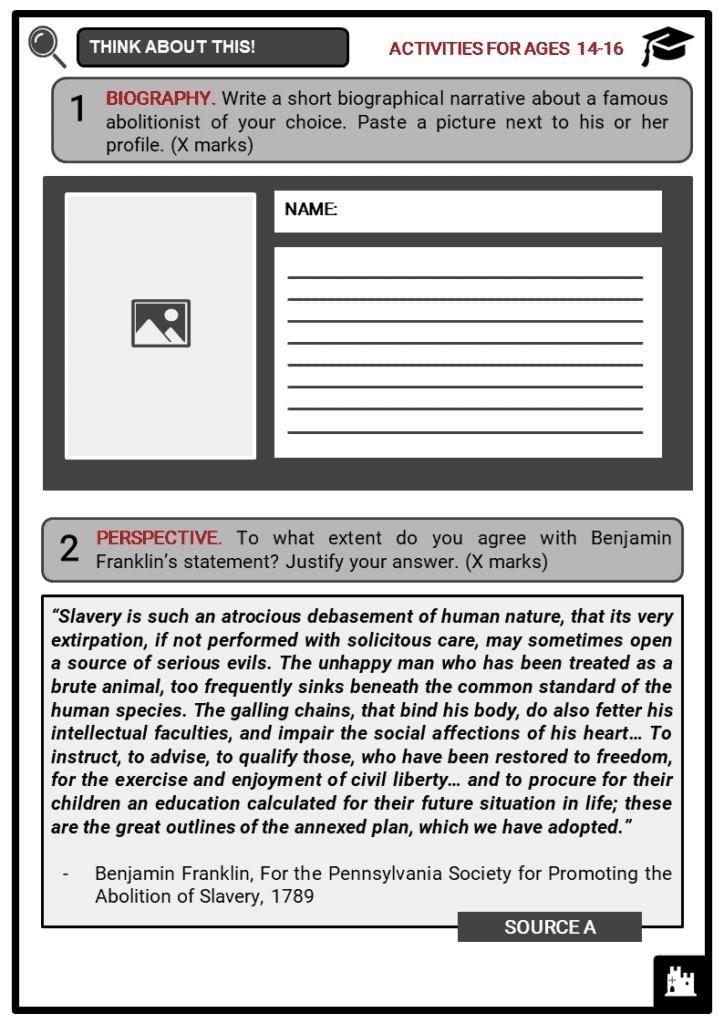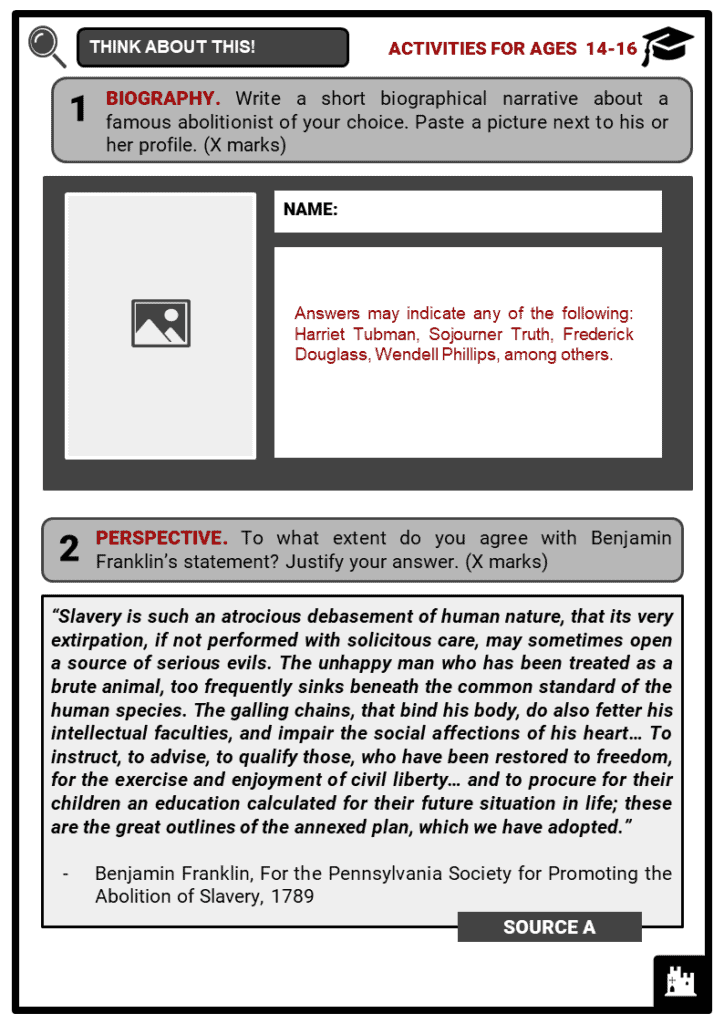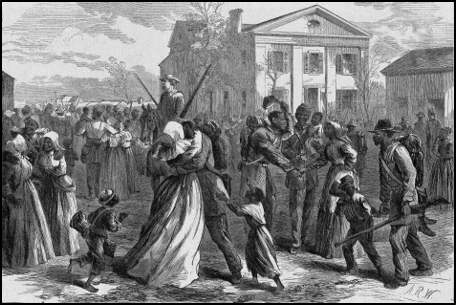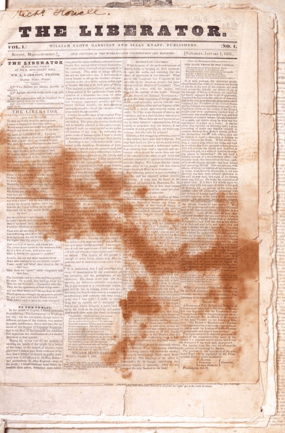Download Abolitionist Movement Worksheets
Do you want to save dozens of hours in time? Get your evenings and weekends back? Be able to teach Abolitionist Movement to your students?
Our worksheet bundle includes a fact file and printable worksheets and student activities. Perfect for both the classroom and homeschooling!
Table of Contents
Add a header to begin generating the table of contents
Summary
- Historical background of the Abolitionist Movement
- Highlights of the Abolitionist Movement
- Activists and prominent leaders of the Abolitionist Movement
- Impact of the Fugitive Slave Act of 1850
Key Facts And Information
Let’s know more about the Abolitionist Movement!
- The Abolitionist Movement advocated for the total emancipation of enslaved people and the end of all forms of racial discrimination. It distinguished itself from those who supported the idea of gradual emancipation of enslaved people and “Free Soil” activists who fought for restricting slavery to specific regions.
- The Abolition Movement was prevalent in the Northern region of America around the beginning of the 1830s. It was one of the contentious differences between the North and South that led to the Civil War.
Opposition to Slavery
- The opposition to slavery started with the view that everyone is equal before God.
- The Quakers were the most vocal and consistent in the disregard for slavery, but so were the Presbyterians, Baptists and the Amish.
- If we allow slaves we act against the very principles by which we associated together, which was to relieve the distresses. Whereas, now we should occasion the misery of thousands in Africa, by setting men upon using arts to buy and bring into perpetual slavery the poor people who now live there free. - James Edward Oglethorpe, 1739
Early Years of the Movement
- From the 1830 to 1870s, the Abolitionist Movement attempted to secure the immediate emancipation of all enslaved people and denounced all forms of racial discrimination.
- This distinguished the abolitionists from those opposing slavery in the westward expansion in the North after an 1840 philosophy labelled Free-soilism.
- Free-soilism refers to the principles of the Free Soil Party in opposition to slavery in the United States in the mid-19th century.
- After the American Revolution, abolition sentiments were strong, with many of the opinions that slavery was inconsistent with the values of the new American nation.
- The majority of the abolitionists at this time were northerners with a few from the northern part of the South.
- In the years after 1820, the southerners began to believe that the northerners were united against them for the emancipation enslaved people.
- During the 1820s, the North experienced increased growth in manufacturing, leading to a vibrant economy.
- The increasing success was met with heightened evangelicalism, leading up to what was known as the Second Great Awakening, meant to remind society of the importance of religion even in the face of economic progress.
- The Missouri Compromise of 1820 that led to Missouri’s admittance into the Union as a slaveholding state, significantly fuelled the North’s abolitionists, the majority of whom were white, upper-middle-class social reformers and clergy members.
Religious Activists
- There were massive religious revivals led by men such as Lyman Beecher, Nathaniel Taylor and Charles G. Finney that called for upholding morality, ending corrupt practices and individual responsibility to defend the will of God in society.
- The religious fervour activists such as Theodore D. Weld, Arthur and Lewis Tappan, William Lloyd Garrison and Elizur Wright, Jr., were on the frontlines of the immediate emancipation clamour.
Highlights of the Abolitionist Movement
Publications
- In early 1831, Garrison began publishing his newspaper The Liberator in Boston, which received support from free African-Americans. He also contributed to the editorial efforts of the Genius of Universal Emancipation, a publication by Benjamin Lundy.
- In 1833, he, Garrison, the Tappans and sixty other delegates founded the American Anti-Slavery Society in Philadelphia, denouncing slavery as a sin, calling for non-violent resistance and denouncing every form of racial discrimination.
- The society rapidly grew over the next two years, with financial and moral support from African-American communities.
- It had branches in every free state, saturating the North with anti-slavery messages, demanding Congress to end all forms of slavery in all the states.
- It also denounced the American Colonisation Society program of voluntary, gradual emancipation and African-American emigration to present-day Liberia and Sierra Leone.
- These led to uprisings and violent responses from pro-slavery camps in the North and South with the pro-slavery camp destroying anti-slavery literature sent to the states and a gag rule over Congress that disallowed the consideration of antislavery petitions.
- The contentions led to the murder of abolitionist Elijah P. Lovejoy in 1837 and the subsequent election of antislavery politicians by northerners afraid of their own civil liberties. Prominent men such as Wendell Phillips, Gerrit Smith and Edmund Quincy joined the cause.
- Whereas the wave of anti-slavery had captured the conscience of the North, there emerged disagreement within the movement.
- In 1840, Garrison and his followers started demanding equal rights for women within the movement and avoidance of corrupt political parties and churches.
- Others in the movement were not on board with the rest of Garrison’s demands and the Tappans founded the American and Foreign Anti-Slavery Society, while others launched the Liberty Party with James G. Birney as the presidential candidate in the 1840 and 1844 elections.
Women’s Rights
- Many people were unhappy with the active role that women took in Garrison’s camp. Debates emerged on the proper role of women in society.
- The women drew parallels between the subjugation of women and the enslavement of Africans. Prominent people such as Lydia Maria Child, Elizabeth Cady Stanton, Lucy Stone and Susan B. Anthony were vocal at the time and went on to form the women’s rights movement and organised the 1848 Seneca Falls Convention.
Public Commentators
- Frederick Douglass, Wendell Phillips and Lucy Stone became extremely well-known as public commentators against slavery. Black literature such as the poetry of John Greenleaf Whittier and James Russell Lowell became popular.
Black Abolitionists
- The autobiographies of fugitives such as Douglass, William and Ellen Craft and Solomon Northup received full attention, and they became prominent African-American abolitionists alongside Harriet Tubman, Sojourner Truth and Sarah Parker Remond.
Methodists and Baptists
- The abolitionists continued to exercise influence over the religious sphere in the society, causing the difference between Methodists (1844) and Baptists (1845), as Methodists were primarily pro-slavery and Baptists were abolitionists.
- The Baptists founded independent “free churches” that continued with the cause of preaching against what had become a significant obstacle to the achievement of individual perfection and a society free from sin.
- The abolitionists founded the Oberlin College, the first move towards racially integrated higher education.
- The Baptists also founded the College Oneida Institute, from which an impressive group of African-American leaders graduated, and Illinois’ Knox College, a western centre of abolitionism.
Fugitive Slave Act of 1850
- African-American activists, however, complained that the white abolitionists were patronising and racists. Nonetheless, the white abolitionists did support African-American anti-segregation efforts and advocacy for better education in black schools in the 1840s and 1850s.
- The Fugitive Slave Act of 1850 saw white abolitionists protecting African-Americans in danger of imprisonment upon their escape from enslavers.
- The whites and blacks also collaborated on the Underground Railroad, a network of individuals, churches and schools that facilitated the escape of enslaved people from slave states and the consequences of the Fugitive Slave Act.
- Harriet Tubman was the most celebrated hero of the Underground Railroad, and most of the success of the network is because of the efforts of black men and women.
End of the Movement
- In 1850, the movement seemed to lose ground after the passage of the Kansas-Nebraska Act that repealed the Missouri compromise, allowing states to determine their own slaveholding status, and the Dred Scott decision that declared the Missouri Compromise unconstitutional.
- Furthermore, John Brown, an American abolitionist, had attempted to spur enslaved people from the south into a resistance war with enslavers and the Commonwealth of Virginia.
- His plan failed and he was hanged for treason, though his final words signalled the inevitable civil war. During the war, abolitionists supported the Union in the secession crisis, championing military emancipation.
- In 1865, with the Thirteenth Amendment passed in the previous year, Garrison declared that the Abolitionist Movement was no longer necessary.
- Wendell Phillips and his camp continued with demands for equality for all African-Americans, including access to land, suffrage and better education until 1870 when he declared “mission accomplished” with the passage of the Fifteenth Amendment.
Image sources:

